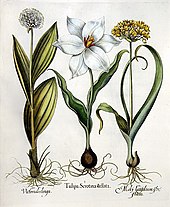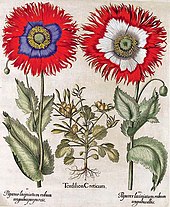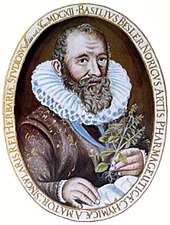Hortus Eystettensis (plant)
Hortvs Eystettensis, Sive Diligens Et Accvrata Omnivm Plantarvm, Florvm, Stirpivm, ex variis Orbis Terrae Partibvs, Singvlari Stvdio Collectarvm Qvae In Celeberrimis Viridariis Arcem Episcopalem Ibid Cingentibvs, Hoc Tempore Conspicivntvr Delineatio Et Ad Vivvm Repraesentatio translated The Garden of Eichstatt, or careful and An exact record and lifelike representation of all those plants, flowers and trees gathered with unique diligence from different parts of the world, which surround the bishopric there in the famous gardens and can be viewed there , is the title of a botanical masterpiece, which was commissioned by Prince-Bishop Johann in 1613 Konrad von Gemmingen (1561-1612) first appeared.
The subject of the work are the plants of the Hortus Eystettensis garden in the Renaissance style at Willibaldsburg in Eichstätt .
Archbishop Gemmingen, who was in office from 1595, commissioned the doctor and botanist Joachim Camerarius (1534–1598) to expand the palace gardens. After Camerarius' death, the Nuremberg pharmacist Basilius Besler (1561–1629) continued his work. The "Hortus Eystettensis" consisted of eight garden areas around the residence on the Willibaldsberg; the gazebos of the Prince Bishop came on a "botanical Stairs" (staircase with plants painted wooden coffered ceiling).
The commissioning of the graphics, which represented the plants shown there, also served to present the power of the bishop.
content
In 1613 the magnificent work “Hortus Eystettensis” was published, written by the pharmacist , botanist, collector, engraver and publisher Basilius Besler from Nuremberg (1561–1629). The printing was probably done in different workshops. The book has 1084 plants in 367 full-page illustrations in the format 56 × 47 cm; a plant is shown on a double leaf that can be folded upwards. In the plant representations, great importance has been attached to ensuring that the plant can be identified without any doubt. Some editions have been colored with great effort, but the uncolored prints are also characterized by their high graphic quality . The copperplate engraving enabled a three-dimensional reproduction of the plants represented by the delicacy of the lines and the hatching overlay of the lines.
The work shows plant species from all over the world, including 349 species that were found in Germany, 209 of southern and south-eastern European origin, 63 Asian, 9 African and 23 American species. It remains to be seen whether these plants all grew in the prince-bishop's garden on Willibaldsburg . The book contains almost all of the cultivated plants known at the time . "Wild plants" such as grasses and mosses, which were already described at the time, are not included, so the book is not a botanical textbook. Nor is it to be addressed as a pharmacopoeia, as only 250 of the plants described have been recognized as having healing properties. Rather, the book is an important contribution to the prince-bishop's, cosmopolitan representation beyond the small principality.
The plants are only shown in their natural size if the book format allowed it; otherwise they are reduced or enlarged. Besler arranged them according to the season of their appearance. Since Besler was not a scientist, he had won the Altdorf botanist Ludwig Jungermann as a co-author. Besler took care of the draftsman and the engraver and was responsible for the text editing and, above all, for the distribution of the book.
The sources of the specialist literature are given, including such famous botanists as Joachim Camerarius the Elder. J. , Charles de l'Écluse (Carolus Clusius), Caspar Bauhin , Leonhart Fuchs , Tabernaemontanus or Matthias de L'Obel (Matthias Lobelius).
Printing history
The “Hortus Eystettensis” went to print in 1613 in two versions, financed by the prince-bishop or his successor. The cost was 12,000 guilders. The first version consisted of a small, high-quality edition, printed on one side, mostly colored (by Georg Mack the Younger or Georg Schneider) and intended as a princely gift; the unit price was 500 guilders. 28 colored copies have survived.
The second version was a cheaper book trade edition with an edition of 300 copies at a unit price of 35 to 48 guilders (for comparison: a stately house cost 2500 guilders at that time, a carpenter's servant earned 8 guilders a month). The first prints can be recognized by their watermarks, the title page with the Gemmingen coat of arms (see picture) and the dedication to Prince-Bishop of Gemmingen, who had died at the time of printing.
In 1613 Besler brought out another print, for cost reasons without the accompanying texts, which were already controversial at the time (edition about 200 copies). The title page and the plant pages remained the same, only the dedication was redesigned to the successor Prince-Bishop Johann Christoph von Westerstetten . Besler's brother Hieronymus had another edition printed in 1627 with a new title page and again without text, but only with 96 plates. Both editions were made without the approval of the Eichstätt diocese.
The copper plates, which were given to Besler for four years according to the contract in 1615, only returned to Eichstätt after Besler's death in 1629 with a few unsold book copies. The prince bishopric brought out another edition in 1640. The dedication pages were changed and the name Besler deleted; Latin-German registers now completed the work.
In 1713 an extended original edition was to appear - probably as an anniversary edition - but only a few copies were printed in 1712. It was not until 1750 that the 5th and last edition was made using the plates from 1612 and the title plate from 1712 with the date changed to 1713. This sold poorly; In 1820 the last 100 copies were blamed. Perhaps the reason for the hesitant sales was that the copper plates had lost quality with each printing process. Botanical science was also more advanced.
For a long time it was assumed that the printing plates had been melted down in 1820. In 1994, 329 of the 366 printing plates were discovered in the Albertina depot in Vienna ; some of them were on view in 2006 in a special exhibition at Willibaldsburg. The University Library Erlangen owns the preliminary drawings, which probably all come from a single source.
The many reprints in particular were often taken apart later, and the single sheets were sold dearly. In 2007, 40 pages of the so-called Weißenhorn copy were taken apart for restoration purposes and shown in a special exhibition at the Diocesan Museum St. Afra Augsburg together with the plants shown in real life.
Preliminary drawings
The preliminary drawings for Basilius Besler's Hortus Eystettensis have been preserved. The 367 pages with all the hand drawings for the 1084 illustrations of the plants can be found under the signature MS. 2370 in the university library in Erlangen. They contain information for the colorists of the print editions, to whom the color and color intensity were precisely specified. The various abbreviations and symbols have not yet been fully deciphered.
literature
- Basilius Besler : Hortus Eystettensis. 1613.
- Catalog for the Hortus Eistettensis. Augsburg 1885 (facsimile edition: Kölbl, Munich 1964)
- Bruno Boegl: A “little narrow garden” Johann Konrad von Gemmingen's “Hortus Eystettensis” . Munich / Murnau 1958.
- Hortus Eystettensis [sive diligens et accurata omnium plantarum, excl.]; Beautiful engravings facsimile excerpt, Munich 1967.
- Hans Baier: The editions of the Hortus Eystettensis. In: From the second-hand bookshop. Volume 26, 1970, pp. A 273 - A 280.
- Hubert Vogl: Hortus Eystettensis . 6 etchings. Schwabach 1980.
- Konrad Kölbl : Kölbl's herbal primer with 73 of the most beautiful copper engravings from the most magnificent plant atlas in botanical history, the “Hortus Eystettensis 1713” by Basilius Besler . Grünwald near Munich 1981
- The Eichstätt garden the large herbarium of Basilius Besler from 1613. Munich 1988. (Reprint from a hand-colored copy of the first edition of the Bibliothèque Nationale de Paris)
- Hortus Eystettensis. To the story of a book . Exhibition catalog. University Library, Erlangen 1989.
- Konrad Wickert : The Erlangen specimens of the "Hortus Eystettensis". Their origins and their fate . Erlangen 1989
- Hortus Eystettensis the Bishop's garden and Besler's magnificent book . Abrams, New York 1995.
- Hortus Eystettensis. A forgotten garden? Exhibition booklet. Eichstatt 1998.
- Veronika Birke: The copper plates of the "Hortus Eystettensis" in the Albertina, Vienna. In: Collection sheet of the Historical Association Eichstätt. Volume 91, 1998, p. 9.
- Brun Appel, Werner Dressendörfer, Hans-Otto Keunecke: The flora of the Hortus Eystettensis. A book is alive . Munich 1998.
- Monika Schattenhofer: “In my little narrow garden” of the Hortus Eystettensis by Johann Conrad von Gemmingen . Munich 1998.
- Regina Doppelbauer among others: The copper plates for "Hortus Eystettensis". In: Viennese history sheets. Volume 54, 1999, pp. 22-32.
- Regina Doppelbauer: The copper plates for the "Hortus Eystettensis" bear witness to past splendor. In: Parnassus. Volume 19, 1999, 1, pp. 101-108.
- Karl Röttel (editor): Contributions to the last court architect and the new "Hortus Eystettensis" . Association of Friends of the Willibald Gymnasium, Eichstätt 1999.
- The Eichstätt garden . Cologne 1999. (Reprint after the hand-colored first edition with a foreword by W. Dressendörfer and KW Littger)
- Daniel Burger : The view of the Hortus Eystettensis. The "Large Altane" on the Willibaldsburg as the art chamber of Eichstätter Bishop Johann Conrad von Gemmingen. In: Research on castles and palaces 5. Munich / Berlin 2000, pp. 187–198.
- Werner Dressendörfer: Hortus Eystettensis. In: flowers, herbs and essences. Darmstadt 2003, p. 42f.
- Werner Dressendörfer: The plants of the Hortus Eystettensis. A botanical and cultural-historical walk through the garden year . 2006.
- Hortus Eystettensis ... Aboca Museum Ed., Sansepolcro (Arezzo) 2006. (Facs reprint of the 1613 edition with commentary volume)
- Duilio Contin: preliminary drawings, copper engravings and coloring in the Hortus Eystettensis. In: Hortus Eystettensis, commentarium. Sansepolcro (Arezzo) 2006, pp. 49-52.
- Siegfried Hagspiel, Melanie Thierbach: Crocus, tulips and Levkojen. Engravings from the "Hortus Eystettensis". Brochure accompanying the exhibition in the Diocesan Museum St. Afra from March 20 to May 20, 2007 . Augsburg 2007.
Web links
- Mara Hofmann, Caroline Zöhl: Hortus Eystettensis. Studies on the creation of the copperplate engraving and the copy by Andrea Vendramin. (PDF) 2003, accessed on January 4, 2013 ( PDF online version on ART-Doc ).
- some colored plates
- History of the garden and the book
- 400 years of Hortus Eystettensis in 2013: online presentation of a colored first edition
Individual evidence
- ↑ Sabine Schulze (Ed.): Gardens: Order - Inspiration - Happiness. Städel Museum, Frankfurt am Main / Hatje Cantz Verlag, Ostfildern 2006, ISBN 3-7757-1870-2 , p. 40.
- ↑ Sabine Schulze (Ed.): Gardens: Order - Inspiration - Happiness. Städel Museum, Frankfurt am Main / Hatje Cantz Verlag, Ostfildern 2006, ISBN 3-7757-1870-2 , p. 46.




